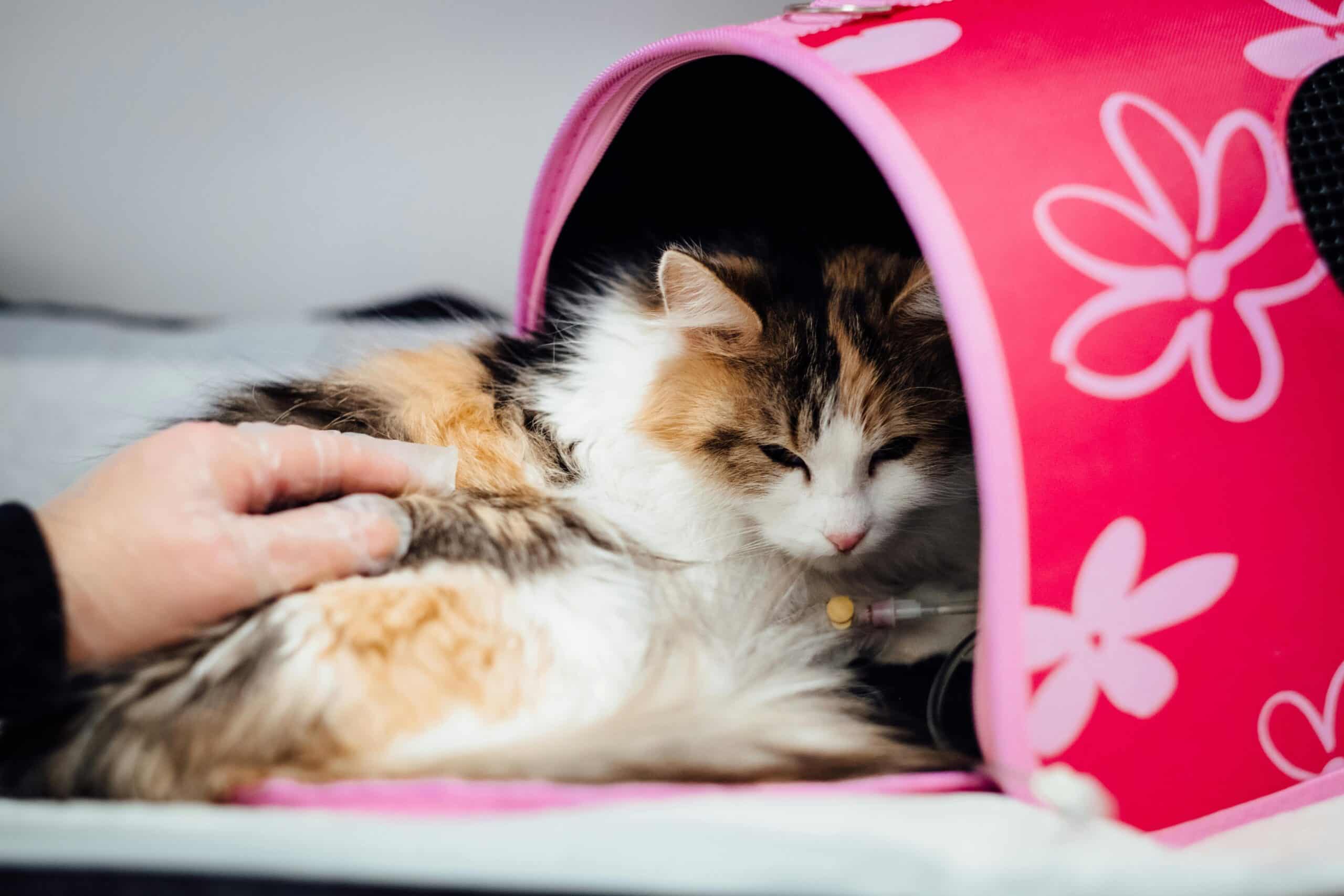Tips for Getting Your Cat Into a Carrier
Posted by Lora Shaw on February 25, 2025

Key Tricks for Getting Your Cat Into a Carrier
- Prepare the carrier in advance by placing it in a quiet, familiar space and lining it with a soft towel or blanket that smells like home to create a comforting environment.
- Use calming techniques, such as minimizing eye contact and trying the “slow blink” method, which helps reduce stress and makes your cat feel more at ease.
- Top-loading carriers can make the process easier, offering more control, less fear, and a gentler experience when placing your cat inside.
- Incorporate positive reinforcement by feeding your cat near or inside the carrier and using pheromone sprays to encourage calm behavior.
- Practice regularly and avoid force, which helps build familiarity and trust, making future vet visits or travel less stressful for both you and your cat.
Getting your cat into a carrier can be a surprisingly tricky task. Whether you’re heading to the vet or traveling, many cat owners know the struggle of convincing their feline friend to cooperate. Cats are naturally independent animals and are often wary of new situations, which can make the sight of a carrier an instant red flag for some. It’s a common challenge, but thankfully it doesn’t have to be stressful. With the right approach, you can make the process much easier for both you and your pet.
From Prep to Success: 10 Easy Tips on How to Get Your Cat Into a Carrier
Let’s explore some simple tips on how to get your cat into a carrier comfortably. From preparing your cat ahead of time to helpful strategies to use during the process, these suggestions will make the experience of getting your cat into a carrier smoother and more stress-free.
1. Prepare the Carrier in Advance
Hours before you need to get your cat into a carrier, set it up in a quiet and familiar space and line it with a soft towel or blanket that smells like home to create a comforting environment.
More tips for success when preparing the carrier include:
- Place the carrier on a stable surface to prevent it from wobbling
- Keep the door open to let your cat explore at their own pace
- Reward your cat with a treat for stepping inside
2. Minimize Eye Contact
When getting your cat into a carrier, avoid direct eye contact as it can feel threatening and may heighten your pet’s anxiety. In a cat’s world, prolonged eye contact is often seen as a sign of confrontation which can make your cat feel uneasy or defensive. Instead, maintain a relaxed posture and let your eyes soften.
To help your cat feel more at ease, try the “slow blink” technique. This is a method cats use to communicate trust and affection, and it works as a calming signal that tells your cat you’re not a threat. By minimizing direct eye contact, you’ll encourage your cat to approach the carrier with lower stress.
3. Try the Top-Loading Carrier Approach
If you’re wondering how to get your cat into a carrier, especially if they resist being led in headfirst, a top-loading carrier might be the solution.
Some benefits of top-loading carriers include:
- More control and comfort – Lowering your cat in gently helps reduce the stress of them being pushed forward into a small space
- Easier positioning – You can adjust your cat’s position with less struggle, ensuring they settle in smoothly
- Reduced fear response – Front-loading can make your cat feel trapped, while top-loading offers a less confined, open-entry experience
4. Use a Towel to Assist
If your cat resists when getting into a carrier or starts to become agitated, wrapping them in a towel can help! This technique keeps them calm and prevents scratches or any sudden escapes, leading to a less stressful environment when making a second attempt.
Once wrapped, you can gently lower your furry friend into the carrier without a struggle. The towel can also stay inside for added comfort.
There are a few best practices when using the towel method, including:
- Choosing a large, soft towel
- Wrapping your cat securely to leave their head exposed
- Holding them close to keep them comforted
5. Create a Calm Environment
A calm environment is key when getting your cat into a carrier, as it helps reduce their stress and make the process much smoother. Cats are highly sensitive to noise and sudden changes in their surroundings, so creating a peaceful setting can go a long way in keeping them cooperative.
Some options for creating a calm environment include:
- Choose a quiet room away from any distractions
- Turn off the TV or any loud appliances
- Place a familiar blanket inside the carrier
- Dim the lights to create a soothing atmosphere
- Speak softly and move slowly
6. Feed Them Near the Carrier
If you’re wondering how to get your cat into a carrier without a struggle, start by making the carrier part of their daily routine. Place their bowl a few feet away from the carrier and gradually move it closer over time. Eventually position the bowl inside the carrier, encouraging them to step in willingly and get used to being inside. Be sure to keep the carrier door open during meals in case your furry friend wants to venture in on their own to explore!
7. Use a Feline Pheromone Spray
Feline pheromone sprays can be a game changer if you’re struggling with how to get your cat into a carrier. These sprays mimic the calming pheromones cats naturally produce, helping to reduce anxiety and stress.
Spray the inside of the carrier 10 to 15 minutes before introducing your cat to give it time to take effect.
8. Avoid Forcing Them
Forcing your cat into a carrier can backfire and create long-term fear. Instead, use a calm, gentle approach to guide them inside. If your cat resists, take a break and try again later. Forcing only increases stress and makes future attempts of getting your cat into a carrier more difficult.
Forcing your cat into a carrier can lead to:
- Fear and anxiety around the carrier
- Increased scratching or biting
- Long-term avoidance of the carrier
- Further difficulty with future vet visits or travel
9. Cover the Carrier Once Inside
After getting your cat into their carrier, keeping them comfortable and relaxed can increase the chances of future success. Covering the carrier with a light blanket or towel will reduce visual stimuli, such as movement or unfamiliar surroundings, both of which can induce stress in your furry friend.
This simple step can create a cozy, secure space for your cat, whether you’re traveling or heading to the vet.
10. Practice Regularly
One of the best tips for how to get your cat into a carrier is to make it a regular part of their routine. Don’t wait for emergency vet visits or travel emergencies – try practicing getting your cat into their carrier every few weeks. Start with short, positive sessions, encouraging your cat to step inside with praise and treats and making sure to reward them afterward.
Regular practice helps because it increases confidence and reduces anxiety, including by:
- Building familiarity and mitigating fear
- Creating positive associations with the carrier
- Making future trips less stressful
Choose Pet Palace for Cat Boarding and Grooming
Once you’ve mastered getting your cat into a carrier, you’re ready for stress-free travel and visits! Whether you’re planning a trip or your cat needs a little extra pampering, Pet Palace is here to help!
Our cat boarding and grooming services are offered in a welcoming, cozy environment where your furry friend will feel right at home. With spacious accommodations, personalized care, and grooming services designed to keep your cat looking and feeling their best, we’ll treat your cat like family.
Ready to give your cat the royal treatment? Check out our locations to find the Pet Palace nearest to you and book your furry friend’s next stay or pampering session.

Categories: All Posts
Archives
Recent Articles
Categories
Monthly Archive
- April 2025
- March 2025
- February 2025
- January 2025
- December 2024
- November 2024
- October 2024
- September 2024
- August 2024
- July 2024
- June 2024
- May 2024
- April 2024
- March 2024
- February 2024
- January 2024
- December 2023
- November 2023
- October 2023
- August 2023
- July 2023
- June 2023
- May 2023
- April 2023
- March 2023
- February 2023
- January 2023
- December 2022
- November 2022
- October 2022
- August 2022
- July 2022
- June 2022
- April 2022
- March 2022
- February 2022
- November 2021
- October 2021
- November 2020
- September 2020
- July 2020
- March 2020
- January 2020
- November 2019
- September 2019
- July 2019
- March 2019
- January 2019
- December 2018
- November 2018
- October 2018
- August 2018
- July 2018
- June 2018
- May 2018
- April 2018
- March 2018
- February 2018
- January 2018
- December 2017
- November 2017
- October 2017
- September 2017
- August 2017
- July 2017
- June 2017
- May 2017
- April 2017
- March 2017
- February 2017
- January 2017
- December 2016
- November 2016
- September 2016
- August 2016
- July 2016
- June 2016
- May 2016
- April 2016
- March 2016
- February 2016
- December 2015
- November 2015
- October 2015
- September 2015
- August 2015
- July 2015
- May 2015
- March 2015
- February 2015
- January 2015
- December 2014
- November 2014
- September 2014
- August 2014
- July 2014
- June 2014
- May 2014
- March 2014
- February 2014
- January 2014
- December 2013
- November 2013
- October 2013
- September 2013
- August 2013
- June 2013
- May 2013
- March 2013
